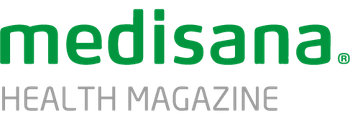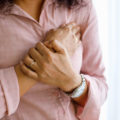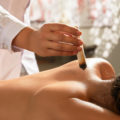Healing power of water

“I don’t think I can cite any remedy,
that heals more surely than water.” (Pastor Sebastian Kneipp)
Sebastian Kneipp – Healing with water
Kneipp medicine (Kneipp therapy) is based on the concepts of Father Sebastian Kneipp (1821-1897) and is founded on the five pillars of lifestyle, water, exercise, nutrition and herbal medicine.
The interplay of these five principles can be used as both preventive and curative treatment. Kneipp is the namesake of Kneipp medicine, and it was only through him that the previously used hydrotherapy, the healing power of water, became popular. The Kneipp philosophy is more important today than ever.
In 1846 Kneipp fell ill with a lung disease. In 1848 he came across Johann Sigmund Hahn’s book “Instructions on the power and effects of fresh water on the human body”. For a while, Kneipp bathed in the ice-cold Danube two to three times a week, took a bath at home and poured water over himself. According to his own statements, he recovered thanks to the healing power of the water.
Daily healing water treatments thereby became an integral part of his everyday life. In 1886 Kneipp wrote his first major work, “Meine Wasserkur” (My water cure), in which he combined hydrotherapy by Johann Sigmund Hahn (a new edition edited by Eucharius Ertel) and herbal medicine. In 1894 Kneipp published his late work “My testament for the healthy and the sick”.
Sebastian Anton Kneipp made Bad Wörishofen in Bavaria the centre of his life and a Kneipp spa, which soon became known beyond national borders throughout Europe.
Kneipp was the first pop star of medicine
Even during his lifetime, Kneipp was something of a medical pop star. Even then, his healing successes by water attracted people from all over the world to Bad Wörishofen. The high nobility came to Kneipp in droves. Even today, Bad Wörishofen is considered the Mecca of all Kneipp fans from all over the world.
The healing power of water
Cold showers are healthy for the circulation: The cold gives your muscles an energy boost. This also applies to your heart, which boosts blood circulation. Cold showers are healthy for the skin and hair: The cold water causes the surfaces of the skin and hair to contract.
With regular use, very cool water acts as a remedy. It activates the metabolism, stabilises the circulation and stimulates the immune system.
The cold stimulus trains the vessels and strengthens the immune system, is effective against varicose veins, spider veins and swollen legs, tightens the skin when losing weight, especially cellulite. With Kneipp, we talk about warm and cold showers. The warm water should have a temperature of 34 to 38 degrees and the cold 8 to 12 degrees.
How do you Kneipp correctly?
Water treading is one of the best-known Kneipp treatments. According to kneippvisite.de, if done regularly, it helps to prevent infections. It is also said to have a balancing effect – calming in the evening and refreshing during the day. The blood circulation, especially in the fine capillaries, is promoted and the veins are strengthened by the cold water. Water treading improves arterial and venous circulatory disorders. This is how it works:
The stork walk according to Kneipp
In the “stork walk” through the cold water: With each step, the legs are lifted out of the water and submerged again until, after half a minute to a minute, a strong feeling of cold appears in the feet and lower legs. After water treading, just wipe off the water, put on socks and shoes and walk briskly at least until you feel warm again.
If you want to use water treading to promote sleep, it should be done immediately before going to bed. The rewarming begins when you cover yourself in bed. But beware, water treading should never be done with cold feet. If you have kidney or bladder problems, you must first consult your doctor.
The Kneipp arm bath
First immerse your right arm, then your left arm, in the cold water up to the middle of your upper arm and leave it in the water for 30 to 40 seconds or until you feel cold pain. But make sure you have a comfortable posture. Afterwards, just wipe off the water and put on clothes to warm up again, swinging your arms.
Cold arm baths strengthen the body’s defences and promote blood circulation in the arms. Blood flow to the heart muscle is stimulated. But be careful: Do not carry out the bath with cold hands. And for arterial circulatory disorders, heart disease or angina pectoris only use with your doctor’s permission.
The upper body wash according to Kneipp
Dip a cloth – cotton is best – in cold water and wring it out. Start on the outside of the little finger on the right arm and go up over the shoulder. Then wash the inside and switch to the left arm. Then wash your neck, chest and stomach, and finally your back. Keep the cloth freshly wet. Wash quickly (approx. one minute), do not dry off, warm up in bed. Do not use in the case of acute serious illnesses and clinical cases requiring surgery.
Caution: Even for small applications, if you have previous illnesses, ask your doctor first! Do not Kneipp if you have an open wound or arterial occlusive disease. Consult a doctor if your feet do not warm up again after a shower (suspected occlusive disease).
Kneipp is an intangible UNESCO cultural heritage
In 2015, UNESCO included Kneipp in its list of intangible cultural heritage as “traditional knowledge and practice based on the teachings of Sebastian Kneipp”.
Stay healthy and have fun when you Kneipp.
Important information
Our posts only contain general information and tips. They are not intended for self-diagnosis, self-treatment or self-medication and do not replace a visit to the doctor.
Sources:
bad-woerishofen.de/fit- gesund/kalteoberkoerperwaschung
Sebastian Kneipp: From my life, published by the Stamm-Kneipp-Verein, Bad Wörishofen 2012.
Bernhard Uehleke: Bad Wörishofen and Sebastian Kneipp 100 years ago. In: Würzburg Medical History Reports, Volume 14, 1996, pp. 441-447, here p. 441.
kneipp-verein-heilbronn.de/richtig-kneippen
Alfred Baumgarten: Sebastian Kneipp. Biographical study. Julius Becker, Berlin 1898. P. 69 et seq.
“Sebastian Kneipp”, Parish of Ottobeuren
domradio.de
Encyclopedia of medical history. 2004, p. 766).




